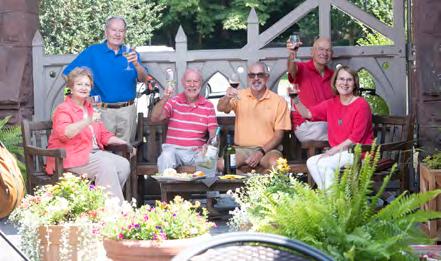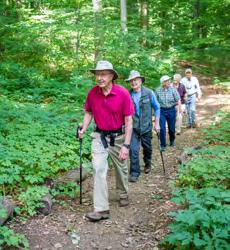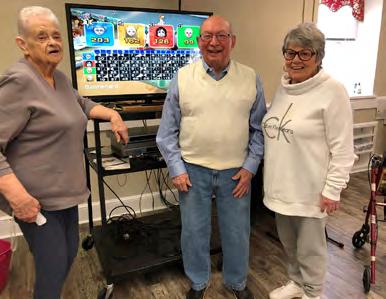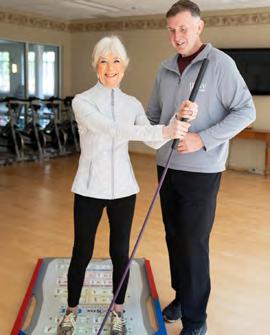
8 minute read
TIME OF YOUR LIFE
WHERE SHOULD YOUR NEXT HOME BE?
Edwin Malet
MAYBE YOU SKIPPED YOUR USUAL AFTER- noon walk because you were “too tired.” Maybe you dropped a plate, spilled some soup or forgot to take your medication ... again.
Perhaps you’ll look around the Thanksgiving table and detect expressions of concern. After dinner, you notice, behind closed doors, your family members are talking. About you.
It’s “time.” Maybe it’s past time.
COMMUNITIES FOR THE INDEPENDENT
Whether to move to a senior living community depends on many factors. You’ll need to do research, but as a first step, you should be aware that there several kinds of communities to choose from.
One kind—a sort of introduction to senior life—is a 55+ community. Harrison Hill Apartments is one of many in our area. Based in West Chester, Harrison Hill offers a no-frills senior lifestyle. Another description would be that it’s a place to “make your own fun”—and economically.
A second general type is called an independent living community. This is usually an apartment—but it may be a separate house, cottage or villa—that’s part of a “life plan” or “continuing care retirement community” (CCRC). But not always.
An independent living community offers a residence in a protected community, generally with convenient access to medical and other services—often meals, housekeeping and home maintenance. Many view an independent living community as a first step in a life plan/CCRC progression.
An independent living resident generally doesn’t require full-time medical care, but the proximity to such care is considered an advantage. Medical care is available on short notice. The Mansion at Rosemont is one example of an independent living facility. Dunwoody Village, Kendal~Crosslands Communities, The Hickman and St. Martha Villa are others in our area.
An independent living resident in some communities can have access to many of the personal care services on an à la carte basis, for example, personal hygiene, housekeeping and transportation. Dunwoody, Kendal~Crosslands and the Mansion at Rosemont, for example, offer “home care”—a kind of hybrid of the two levels of care, with the intent of letting residents remain in independent living longer.
Friends Home in Kennett offers “supportive” independent living for residents presently in need of no care. As the supportive units are in the personal care building (see below), when care is needed, no move is necessary.
THE NEXT LEVEL OF CARE
A third kind of community is “personal care” or “assisted living.” Practically speaking, these communities offer similar levels of care. For convenience, I’ll refer to them as personal care.
Personal care living is for those who require semi-continuous attention, generally from nurses, doctors or other trained personnel. The staff, however, are less involved in residents’ lives than in a hospital or skilled nursing facility, a fourth level of care.
The residents in personal care may occupy apartments comparable to their independent living counterparts. But they have access to meal preparation, medication management, housekeeping services, transportation and other staff-provided services to assist with activities of daily living.
A fourth level of care is a “nursing home” or “skilled nursing facility.” These are longterm, 24-hour-care facilities, staffed with medically trained personnel. Typically one goes to a nursing home or skilled nursing facility when it’s medically necessary. There are over 20 such facilities in Chester County.

RIGHT TIME OR RIGHT PLACE
Many prospective senior living residents extol the “right time” as their deciding factor on whether to move to a senior living facility. For instance, Samantha Gordon, the Communications and Outreach Manager at The Hickman, says the right time is the “time we need an extra hand, time we are ready to enjoy our retirement, time to give our loved one a break.”
Surely, she is right. In practice, though, whether it’s the right time will also depend heavily on the place—the setting and accommodations, the services and facilities, both on-campus and off. You’ll want to consider factors such as transportation options, religious services, meal preparation, and of course access to medical services. Other considerations include the activities available, and whether they’re planned by an administrator or individually available. These considerations will determine whether your move would be a happy one.
Michele Berardi, Director of Communications and Public Relations at Kendal~Crosslands Communities, for instance, points out that location is also key. She would ask if the community is near their doctors, children, where they grew up, their church and their friends.

FRIENDS AND COMMUNITY
Terry Blair, a resident at The Mansion at Rosemont, wanted to be close to her Main Line family. She did an extensive on-line search, narrowed to three places and finally chose The Mansion. “It’s really lovely,” she says, noting that it offers transportation, trips to the opera and symphony, wellness programs, exercise, volunteering and more. And it’s close to her friends! Its Director of Marketing, Sarah Jolles, says the Main Line location is a major attraction. The residents “love where they live.”
Type of living accommodations may also be important in choosing a community. Some want a “campus feel.” Others prefer a separate apartment or cottage.
Ginna Clark, a resident at White Horse Village, “loves the green grass around the buildings.” It’s a “great place to walk.” She likes the wellness center, the pool, the trainers and dining facilities. She’s also taken by the “incredible food,” the hiking trips, performances and lectures. A former resident of Swarthmore, she “couldn’t be happier at White Horse Village.”
Originally from Wilmington, North Carolina, Bruce and Karen Gibson moved into White Horse Village in Newtown Square—they referred to it as “idyllic”—to be close to their daughter and two sons. Bruce likes the garden and woodworking shop. Karen, who has had back surgery and issues with her eyes, appreciates the medical services that are widely available in the area. Bruce also considers the nonprofit philosophy of White Horse a plus.
Since 2013, Susan Fischer has called Lima Estates home, enjoying the “friendliness” and “warmth” of the community, and the fact that everything—swimming pool, gift shop, beauty parlors, transportation—

Kendal~Crosslands Harrison Hill Apartments


Friends Home in Kennett Riddle Village
is right there. She describes it as a “happy place.” Susan hasn’t needed additional services yet, but she takes comfort that personal care and skilled nursing are there if and when she needs them.
Some will choose to sacrifice the suburban settings near Philadelphia and head west to Lancaster and Lebanon Counties. Jennifer Margut, Vice President of Cornwall Manor, believes her residents—40% from out-of-state, 40% from central Pennsylvania, and 20% from the Philadelphia area—have chosen Cornwall because of its rural setting: trees, hills, low cost of living and small town feel. That’s retirement!
COST
Cost is an essential consideration in choosing a new community. Cost considerations include the monthly cost, upfront costs and incidentals. Other questions to
White Horse Village consider: Does the community accept your long-term care insurance? How much do you have to pay when moving through the continuum of care?
Gordon at The Hickman says, “Financial considerations have a huge impact and dictate whether a person qualifies to live at a community and for how long. Communities may be private-pay based or supported through Medicaid/Medicare. It’s important to consider every cost before moving in. This means checking if there are any buyin fees, extra fees, one-time admission fees and even amenities fees—for example if a community offers a hair salon that might be an extra cost for each use.”
Nonprofit versus for-profit status is another consideration, along with accreditations and ratings for healthcare. CARF (Commission on Accreditation of Rehabilitation Facilities), for example, is a kind of Good Housekeeping seal of approval and important to check out.
TRANSITIONING
At Kendal~Crosslands Communities, transitioning from independent living to personal care is a team decision, involving the resident, social services staff, doctors and sometimes the family members. Berardi says, “Most times, residents know when it’s time, which may be when life becomes more challenging than it has to be. Aging in the right place is essential, and … it’s one of our values of being in a community with one another. The sense of community never ceases, and each person’s human rights and needs are always first and foremost. We preserve dignity and self-respect, and staying connected no matter where you are in your life journey is essential.”
Kristen Lammana, of Riddle Village, says sometimes transitioning will be triggered by the family, staff, physician or an accident. “Things like confusion, increased falls or a change in personality can be noticed by the staff. When a problem is brought to the attention of the community, our staff works together with the resident and their loved ones to put a plan into action to ensure a safe living environment.”
Dunwoody Village also takes transitioning very seriously, says Maureen Casey, its President and CEO. Dunwoody has contracted with the University of Pennsylvania to study and provide advice on the challenges residents face. And, through its home care services, it provides a diverse set of assistance—everything from shopping to dog-walking to moving trash cans—to keep residents in place for as long as possible.
There are many things to consider when selecting a move to a senior community. Closeness of family and friends, accommodations and environment, quality of health care available, philosophy of management, the future and more. For many, the wide variety of choice leads to procrastination and analysis paralysis.
Our recommendation: study and plan, but don’t wait to make your move. The good life is waiting for you. ©






